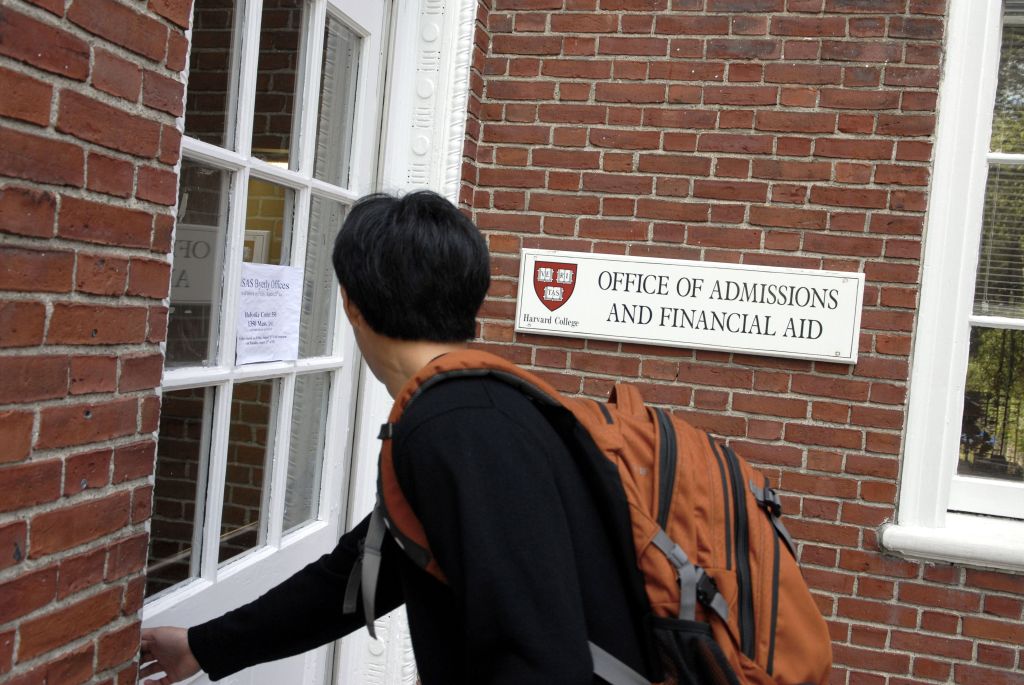College Legacy Admissions: 'Affirmative Action' For White Students Must End
‘Affirmative Action’ For Wealthy, White Students: Why Colleges’ Legacy Admissions Must End Now

A student enters the Admissions Building at Harvard University on September 12, 2006, in Cambridge, Massachusetts. | Source: Getty Images / Getty
In 1963, Duke University admitted its first five Black undergraduates.
When I walked onto campus as a freshman 29 years later, most of my Black classmates and I were still the first in our families to attend the prestigious university. We—like many lower-income students across racial and ethnic backgrounds and first-generation college students—could not benefit from the legacy preference that was extended to our white, wealthier peers—a privilege bestowed upon applicants whose parents or grandparents are alum of the school.
While the United States Supreme Court prepares to decide whether race-based affirmative action should persist, legacy admissions—essentially “affirmative action” for wealthy and white students—remain untouched.
MORE: The College Admission Scandal Is A Reminder Of A Broken System Against Black Folks
It’s time to demand colleges and universities end the unfair, unjust, and unearned privilege of legacy admissions that has excluded students of color and low-income students for decades.
Among the top 30 universities, legacy students have a 45% greater chance of being admitted than non-legacy students and fill between 10% and 25% of all available slots in an incoming class.
https://twitter.com/dylanmatt/status/1488942324235313154?s=20&t=c7BODWHLIgNVO8kcr6mRIA
By definition, zero first-generation college students are admitted under a legacy preference, and virtually no legacy student attending an elite institution is low-income. At the top 10 universities, there have been more white students admitted who have benefited from an “alumni preference” than there have been Black or Latinx students admitted through affirmative action policies.
While my alma mater does not disclose the percentage of students annually who are admitted under a legacy preference, the University considers familial alumni status for applicants during the admissions process.
My children have already benefitted from access to high-quality public schools, two parents with advanced degrees and a plethora of supplemental educational opportunities—in no small part due to the privilege my college degree and law degree have bestowed upon me. When it’s their turn to apply to college in a few years, if they choose to apply to Duke, they shouldn’t be given preference in the admissions process simply because it’s my alma mater.
The way to make admissions fairer and more accessible isn’t to perpetuate privilege among a few, but to stop inequitable admissions policies entirely. If something is not just in the main, but overwhelmingly working simply to prop up white, wealthy students, then it is not actually working – at least not as it should in America.
Several colleges, including Amherst College and the University of Colorado system, have recently ended the practice of legacy admissions, yet it is still a far too prevalent practice among some of nation’s top institutions—the gatekeepers to opportunity.
The prevailing reason why top universities have maintained legacy preferences is largely financial: to secure alumni giving. Yet both research and real-life case studies have proven that this belief is largely inaccurate. After Texas A&M University and the University of Texas (UT) ended legacy preferences, Texas A&M significantly outperformed comparative schools in terms of dollars raised and UT saw growth in alumni giving.
Now, thanks to the leadership of Oregon Sen. Jeff Merkley and New York Rep. Jamaal Bowman, this excuse will become even less credible.
Last week, the pair introduced the “Fair Admissions for Students Act,” which would prohibit institutions of higher education participating in Federal student assistance programs from giving preferential treatment in the admissions process to either legacy students or donors. The amendment would be part of the overdue reauthorization of the Higher Education Act. Colleges and universities that want to continue promoting exclusionary racist and classist practices would be barred from accessing federal funding—funding that could instead go to support schools that don’t have the massive endowments of elite colleges and that are admitting and graduating large percentages of students of color and students from low-income backgrounds.
If our nation, through the judicial system, is eager to question whether race-based affirmative action policies at Harvard University and UNC-Chapel Hill are constitutional, then we should be as eager to also question the practice of legacy “affirmative action” policies for the already privileged. Now couldn’t be a more fitting time for Congress to support the “Fair Admissions for Students Act.”
Opportunity will never be equitably distributed until our entire education system is reimagined to serve the very students it was originally designed to exclude. Ending the legacy preference is one small, but important step toward that change.
Shavar Jeffries is president of Education Reform Now.
SEE ALSO:
Here’s How Harvard’s Affirmative Action Case Affects Future Black Students
HBCU President Testifies In Harvard University’s Affirmative Action Case
















